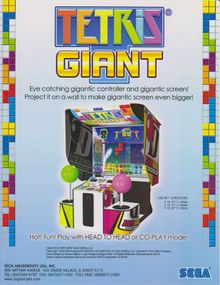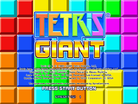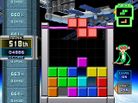Tetris Giant: Difference between revisions
No edit summary |
No edit summary |
||
| Line 19: | Line 19: | ||
== Gameplay == | == Gameplay == | ||
Everything is giant in ''Tetris Giant'', including the blocks. The [[playfield]] is 6 × 7 instead of the normal 10 × 20. The game lacks [[ | Everything is giant in ''Tetris Giant'', including the blocks. The [[playfield]] is 6 × 7 instead of the normal 10 × 20. The game lacks [[hard drop]], and there is no way to manually lock pieces, or hold pieces, so managing a good stack and odd pieces is very important. | ||
Arcade operators can choose to allow the selection of Kids Mode, which limits the available tetrominoes to JLOIT. | Arcade operators can choose to allow the selection of Kids Mode, which limits the available tetrominoes to JLOIT. | ||
Revision as of 07:56, 19 September 2019
| Tetris Giant | |
|---|---|
 Promotional flyer | |
| Developer(s) | Sega AM1 |
| Publisher(s) | Sega |
| Platform(s) | Arcade |
| Release |
|
| Gameplay info | |
| Next pieces | 2 |
| Playfield size | 6 × 7 |
| Hold piece | No |
| Hard drop | No |
| Rotation system | SRS |
Tetris Giant (known as テトリス デカリス Tetris Dekaris in Japan) is a Tetris arcade game developed and published by Sega.[2] The game is played using giant versions of ball top joysticks called Dekacons, on a cabinet with a 70" projector screen.
Gameplay
Everything is giant in Tetris Giant, including the blocks. The playfield is 6 × 7 instead of the normal 10 × 20. The game lacks hard drop, and there is no way to manually lock pieces, or hold pieces, so managing a good stack and odd pieces is very important.
Arcade operators can choose to allow the selection of Kids Mode, which limits the available tetrominoes to JLOIT.
Score Attack Mode
The goal of Score Attack Mode is to score as many points as possible within the 200 line limit, or before topping out. On the left, the Ranking Tower displays the rank in real time, compared to other scores on the machine.
| Action | Points |
|---|---|
| Single | 10 × level |
| Double | 30 × level |
| Triple | 50 × level |
| Tetris | 500 × level |
| T-Spin | 40 × level |
| T-Spin Single | 90 × level |
| T-Spin Double | 150 × level |
| T-Spin Triple | 210 × level |
| Soft Drop | 2 ÷ cell |
Levels increase every 10 lines, and caps at level 15.
Line Attack Mode
In this mode, the goal is to clear as many lines as possible before the time runs out or the 200 line limit is reached. Bonus time is given when line clears are made. Topping out does not end the game, instead the field is cleared and a time penalty is given.
| Action | Time |
|---|---|
| Single | 0 s |
| Double | +2 s |
| Triple | +5 s |
| Tetris | +20 s |
2P Score Attack Mode & 2P Line Attack Mode
In 2P mode, two players play cooperatively in a 12 × 7 playfield. The middle two rows are shared, and a player can not move their active piece past that area. You can exchange each other's pieces up to three times.
2P Battle Mode
If the player clears more than one line at a time, the opponent's piece will speed up and drop faster, it's also possible for the Dekacon to vibrate when this happens. The first person to win two rounds is the winner.
Development
Tetris Dekaris was announced by Sega on September 11, 2009, and was first playable at the 47th Amusement Machine Show on September 17, 2009.[3] In 2011, A 47” LCD version of the cabinet was also developed, but was only produced in limited quantities.
Reception
During the 47th Amusement Machine Show, Amusement Journal asked attendees to fill out a questionnaire of their favorite games. Tetris Dekaris ranked second most popular arcade game on the first two days, and most popular on the last day.[4] As of April 28, 2010, the official website listed 424 locations with a cabinet in operation in Japan.[5]
References
- ↑ https://web.archive.org/web/20131016165342/http://dekaris.sega.jp/about/
- ↑ https://sega-interactive.co.jp/product/7963/
- ↑ "Deka kute tanoshī tetorisu tōjō" [Tetris Appears Big and Fun]. Archived from the original on 2013-12-08. Retrieved 2019-09-19.
- ↑ "". 2009-09-17. Archived from the original on 2019-09-19. Retrieved 2019-09-19.
- ↑ "Setchi tenpo ichiran" [List of installation stores]. 2010-04-28. Archived from the original on 2013-10-18. Retrieved 2019-09-19.
External links
- Official website - Archive
- Tetris Dekaris on Sega Arcade Game History
- Tetris Dekaris promo video (『テトリス・デカリス™』プロモーションムービー “Tetorisu dekarisu™” puromōshonmūbī)
| |||||||||||

